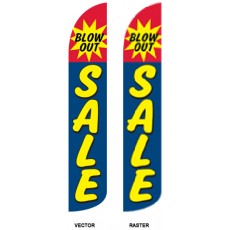
When working with graphic design software to design a custom feather flag, there are many format choices available: jpg, gif, png, pdf, eps, ai, and many more. Amongst the many formats available, there are two basic types of graphics files - vector and raster. Raster images are comprised of pixels, whereas vector images are comprised of a series of points and paths which are, at their core, mathematical in nature. For custom flags, we require that artwork to be submitted in either vector format or a very high resolution raster image. Understanding the difference between raster and vector graphics will help you in submission of your custom flag artwork.
Raster Images
Raster images are comprised of pixels, which are the smallest elements of display on a monitor. If you zoom in to a raster image, you will notice a lot of tiny squares, which are the pixels. Raster images have a fixed number of pixels, which makes it impossible to resize them without compromising the image quality. In particular, enlarging a pixel-based image will result in a grainy-looking, distorted image, since the pixels will simply be enlarged.
The most common raster image types include .jpeg, .gif, and .png. Most images you find on the web and in print catalogs are raster images. In particular, photographs are always raster images. In most cases when customers provide logo artwork in a raster format, the logo is designed to be used in smaller applications such as on the web or for print on business cards. Because of the large size of feather flags, we require very large scale artwork files in order to achieve a high print quality. We recommend against using raster images for custom feather flags, however, will use them in some rare cases if the customer is able to provide a very high resolution raster that is 300dpi or greater at the actual size of the flag.
Image Resolution
When working with raster images, you must ensure that the image has a high resolution at the size it will be printed. Resolution refers to number of pixels in one inch of the image, which is signified by dots per inch (DPI). For web pages a relatively low pixel density of 72dpi is adequate, but the same low DPI image will produce poor results when printed in large-scale. To adequately print a raster image on a feather flag, make sure it is at least 300dpi at the actual size of the feather flag.
Vector Graphics
In contrast, vector images are essentially mathematical calculations from one point to another that form shapes and lines. Zooming into a vector graphic will not change its appearance, since they are infinitely scalable. When you enlarge a vector graphic, there is no quality loss since the mathematical formulas remain intact. Feather flags are very large in scale, so having artwork which is scalable is extremely important and thus makes vector formats the ideal choice.
The most common vector file types are .ai and .eps. Your logo and brand graphics, designed as a vector file, will be easily resized and transferred onto a feather flag without compromising the image quality.
Remember to Convert Fonts to Outlines
It is important to remember to convert all fonts to outlines before submitting your vector file. Otherwise, you will be dependent upon us having the fonts you used in your design installed on our computer. By converting fonts to outlines, the fonts are changed to paths which are mathematical formulas, and therefore can be displayed by any computer regardless of whether or not the chosen font is installed.
Beware of Raster Images Embedded in Vector Files
One point that is important to note is that Raster images can be embedded into vector files. Sometimes customers will send us artwork that is saved as a .ai or .eps file, but when we open the file, we find that a raster image has actually just been embedded. Embedding a raster image into a vector file will not suffice, we require a true vector file to achieve the desired high-quality imprint.
File Formats
Vector and raster images can be saved in various formats. The file extension will often indicate which software was used to create the graphic.
Some common vector file formats include .ai (created in Adobe Illustrator) and .cdr (created in Corel Draw). EPS is also a common vector file extension which is very popular since it is supported by both Adobe Illustrator and Corel Draw which are the two most popular vector manipulation applications. Adobe Portable Document Format (.pdf) is another popular format which is used across almost all graphic design applications and can support both vector and raster files.
The most common types of raster files are .jpg (JPEG), .gif (GIF transparent file), .tiff (Tag Interleave Format), .png (Portable Network Graphic Transparent File), and .psd (Adobe Photoshop file).
Our Accepted Formats
We work with adobe illustrator as our in-house vector software, and therefore we can accept vector files with the extension .ai, .eps, or .pdf. If you created your file in Corel Draw or any other application, we suggest saving the file as .eps or .pdf. We can also accept almost any format of raster image including .jpg, .png, .tiff, .png, or .psd as long as the image is of very high resolution.
Knowing the difference between vector and raster images will help you create a usable image file for your custom feather flag. The best option will be to use vector images; however, raster images of very high resolution are also suitable for custom feather flag printing.
